Tracking W-Formate Dehydrogenase Structural Changes During Catalysis and Enzyme Reoxidation
Abstract
1. Introduction
2. Results
2.1. Time-Resolved Reduction of As-Isolated DvFdhAB Crystals
2.2. Reoxidation of Formate Reduced DvFdhAB
3. Discussion
4. Materials and Methods
4.1. Expression and Purification of D. vulgaris FdhAB
4.2. Crystallization, Data Collection, Structure Solution, and Refinement
4.3. Solution Kinetic Assays under Crystallization Conditions
Supplementary Materials
Author Contributions
Funding
Data Availability Statement
Acknowledgments
Conflicts of Interest
References
- Stevens, A.N.P. Factors Affecting Global Climate. Nat. Educ. Knowl. 2011, 3, 18. Available online: https://www.nature.com/scitable/knowledge/library/factors-affecting-global-climate-17079163/ (accessed on 24 June 2022).
- Oliveira, A.R.; Mota, C.; Mourato, C.; Domingos, R.M.; Santos, M.F.A.; Gesto, D.; Guigliarelli, B.; Santos-Silva, T.; Romão, M.J.; Cardoso Pereira, I.A. Toward the Mechanistic Understanding of Enzymatic CO2 Reduction. ACS Catal. 2020, 10, 3844–3856. [Google Scholar] [CrossRef]
- Oliveira, A.R.; Mota, C.; Klymanska, K.; Biaso, F.; Romão, M.J.; Guigliarelli, B.; Pereira, I.C. Spectroscopic and structural characterization of reduced D. vulgaris Hildenborough W-FdhAB reveals stable metal coordination during catalysis. ACS Chem. Biol. 2022, 17, 1901–1909. [Google Scholar] [CrossRef] [PubMed]
- Raaijmakers, H.C.A.; Romão, M.J. Formate-reduced E. coli formate dehydrogenase H: The reinterpretation of the crystal structure suggests a new reaction mechanism. J. Biol. Inorg. Chem. 2006, 11, 849–854. [Google Scholar] [CrossRef] [PubMed]
- Schrapers, P.; Hartmann, T.; Kositzki, R.; Dau, H.; Reschke, S.; Schulzke, C.; Leimkühler, S.; Haumann, M. Sulfido and cysteine ligation changes at the molybdenum cofactor during substrate conversion by formate dehydrogenase (fdh) from rhodobacter capsulatus. Inorg. Chem. 2015, 54, 3260–3271. [Google Scholar] [CrossRef] [PubMed]
- Mota, C.S.; Rivas, M.G.; Brondino, C.D.; Moura, I.; Moura, J.J.G.; González, P.J.; Cerqueira, N.M.F.S.A. The mechanism of formate oxidation by metal-dependent formate dehydrogenases. J. Biol. Inorg. Chem. 2011, 16, 1255–1268. [Google Scholar] [CrossRef] [PubMed]
- Cerqueira, N.M.F.S.A.; Fernandes, P.A.; Gonzalez, P.J.; Moura, J.J.G.; Ramos, M.J. The sulfur shift: An activation mechanism for periplasmic nitrate reductase and formate dehydrogenase. Inorg. Chem. 2013, 52, 10766–10772. [Google Scholar] [CrossRef] [PubMed]
- Dong, G.; Ryde, U. Reaction mechanism of formate dehydrogenase studied by computational methods. J. Biol. Inorg. Chem. 2018, 23, 1243–1254. [Google Scholar] [CrossRef] [PubMed]
- Laun, K.; Duffus, B.; Wahlefeld, S.M.; Katz, S.; Belger, D.; Hildebrandt, P.; Mroginski, M.A.; Leimkühler, S.; Zebger, I. Infrared spectroscopy elucidates the inhibitor binding sites in a metal-dependent formate dehydrogenase. Chem. Eur. J. 2022, 28, e202201091. [Google Scholar] [CrossRef] [PubMed]
- Mehrabi, P.; Schulz, E.; Agthe, M.; Horrell, S.; Bourenkov, G.; von Stetten, D.; Leimkohl, J.-P.; Schikora, H.; Schneider, T.; Pearson, A.; et al. Liquid application method for time-resolved analyses by serial synchrotron crystallography. Nat. Methods 2019, 16, 979–982. [Google Scholar] [CrossRef] [PubMed]
- Mehrabi, P.; Muller-Werkmeister, H.M.; Leimkohl, J.P.; Schikora, H.; Ninkovic, J.; Krivokuca, S.; Andricek, L.; Epp, S.W.; Sherrell, D.; Owen, R.L. The HARE chip for efficient time-resolved serial synchrotron crystallography. J. Synchrotron. Radiat. 2020, 27, 360–370. [Google Scholar] [CrossRef] [PubMed]
- Nurizzo, D.; Mairs, T.; Guijarro, M.; Rey, V.; Meyer, J.; Fajardo, P.; Chavanne, J.; Biasci, J.C.; McSweeney, S.; Mitchell, E. The ID23-1 structural biology beamline at the ESRF. J. Synchrotron. Radiat. 2006, 13, 227–238. [Google Scholar] [CrossRef] [PubMed]
- McCarthy, A.; Barrett, R.; Beteva, A.; Caserotto, H.; Dobias, F.; Felisaz, F.; Giraud, T.; Guijarro, M.; Janocha, R.; Khadrouche, A.; et al. ID30B—A versatile beamline for macromolecular crystallography experiments at the ESRF. J. Synchrotron. Radiat. 2018, 25, 1249–1260. [Google Scholar] [CrossRef] [PubMed]
- Vonrhein, C.; Flensburg, C.; Keller, P.; Sharff, A.; Smart, O.; Paciorek, W.; Womack, T.; Bricogne, G. Data processing and analysis with the autoPROC toolbox. Acta Cryst. D Biol. Crystallogr. 2011, 67, 293–302. [Google Scholar] [CrossRef] [PubMed]
- Vonrhein, C.; Tickle, I.J.; Flensburg, C.; Keller, P.; Paciorek, W.; Sharff, A.; Bricogne, G. Advances in automated data analysis and processing within autoPROC, combined with improved characterisation, mitigation and visualisation of the anisotropy of diffraction limits using STARANISO. Acta Cryst. A Found Adv. 2018, 74, 43537. [Google Scholar] [CrossRef]
- Mccoy, A.J.; Grosse-kunstleve, R.W.; Adams, P.D.; Winn, M.D.; Storoni, L.C.; Read, R.J. Phaser crystallographic software. J. Appl. Crystallogr. 2007, 40, 658–674. [Google Scholar] [CrossRef] [PubMed]
- Winn, M.D.; Ballard, C.C.; Cowtan, K.D.; Dodson, E.J.; Emsley, P.; Evans, P.R.; Keegan, R.M.; Krissinel, E.B.; Leslie, A.G.W.; McCoy, A.; et al. Overview of the CCP4 suite and current developments. Acta Cryst. D Biol. Crystallogr. 2010, 67, 235–242. [Google Scholar] [CrossRef] [PubMed]
- Emsley, P.; Lohkamp, B.; Scott, W.G.; Cowtan, K. Features and development of Coot. Acta Cryst. D Biol. Crystallogr. 2010, 66, 486–501. [Google Scholar] [CrossRef] [PubMed]
- Vagin, A.A.; Steiner, R.A.; Lebedev, A.A.; Potterton, L.; McNicholas, S.; Long, F.; Murshudov, G.N. REFMAC5 dictionary: Organization of prior chemical knowledge and guidelines for its use. Acta Cryst. D Biol. Crystallogr. 2004, 60, 2184–2195. [Google Scholar] [CrossRef] [PubMed]
- Joosten, R.P.; Salzemann, J.; Bloch, V.; Stockinger, H.; Berglund, A.C.; Blanchet, C.; Bongcam-Rudloff, E.; Combet, C.; da Costa, A.L.; Deleage, G. PDB-REDO: Automated re-refinement of X-ray structure models in the PDB. J. Appl. Crystallogr. 2009, 42, 376–384. [Google Scholar] [CrossRef] [PubMed]
- Schrodinger, L.L.C. The PyMOL Molecular Graphics System, Version 4.5; Schrodinger L.L.C: New York, NY, USA, 2019. [Google Scholar]

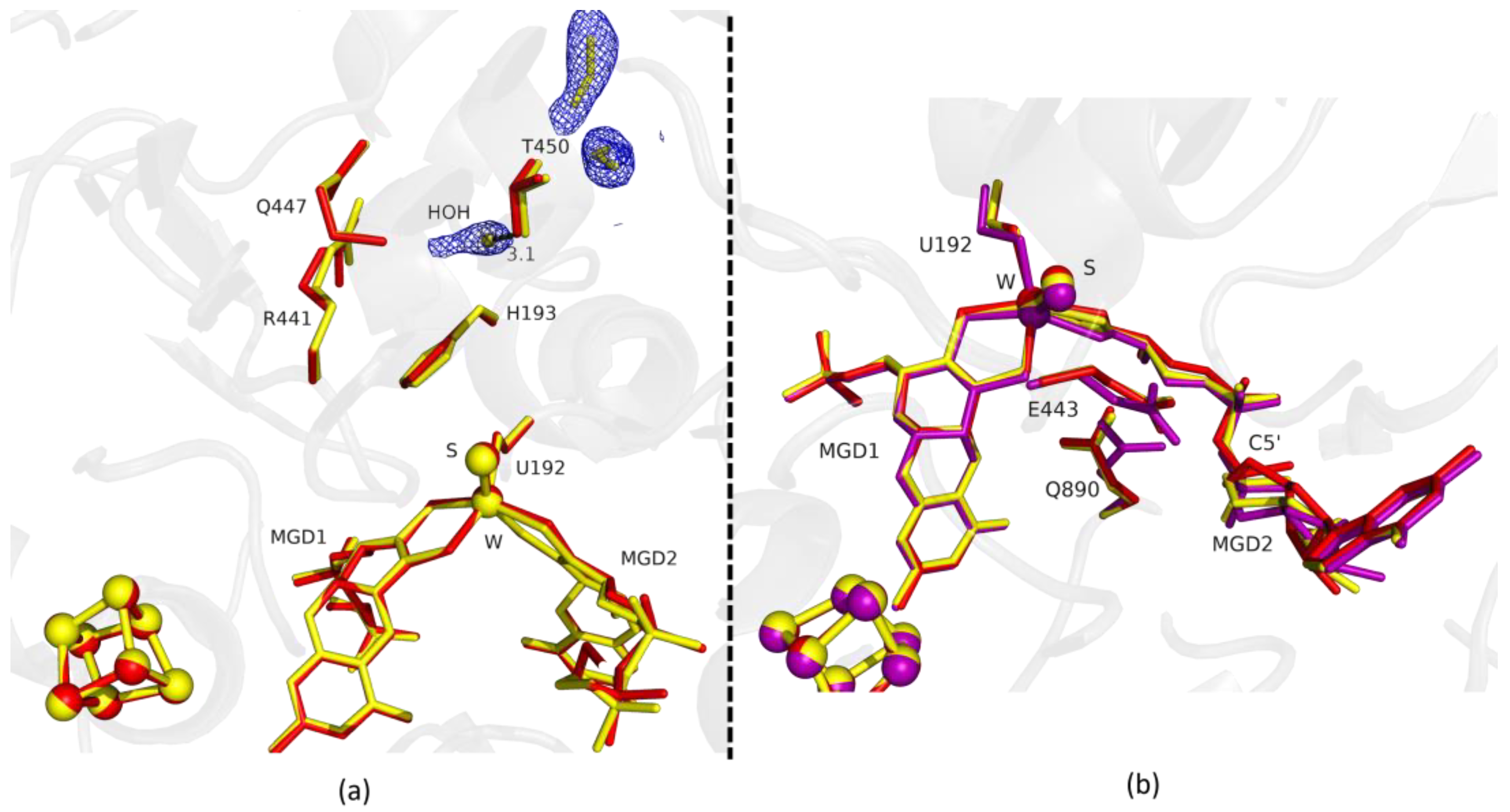
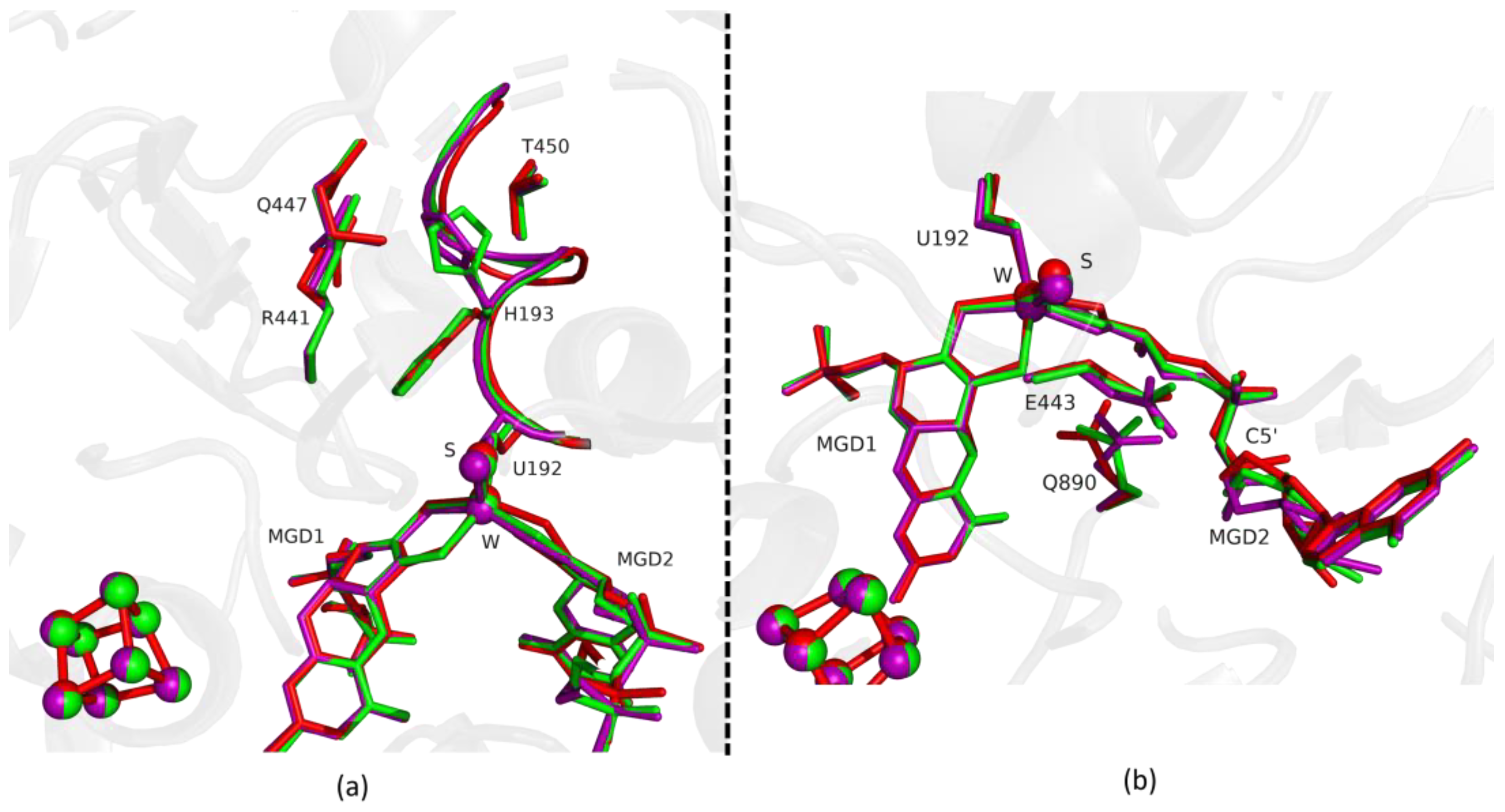
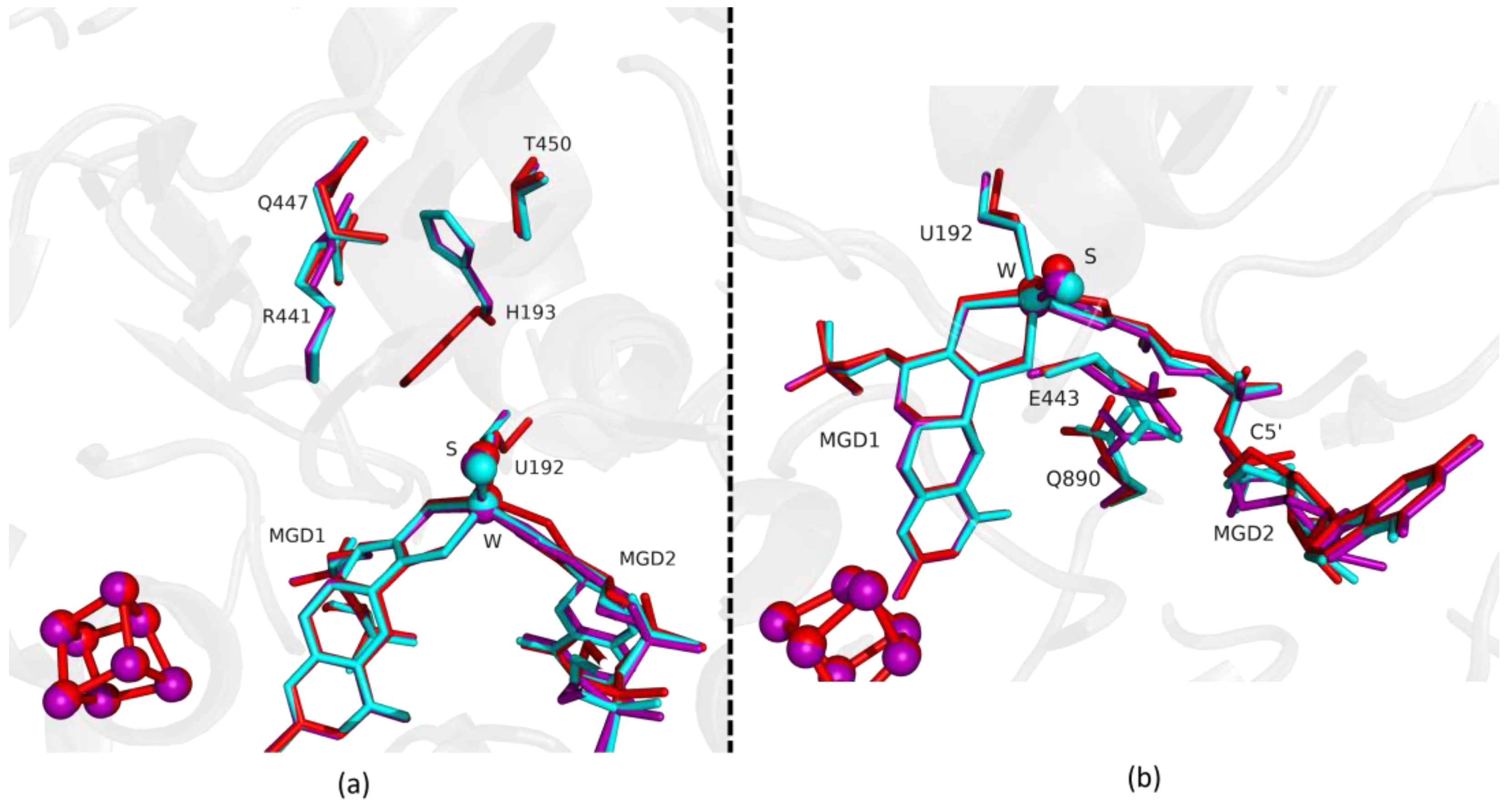
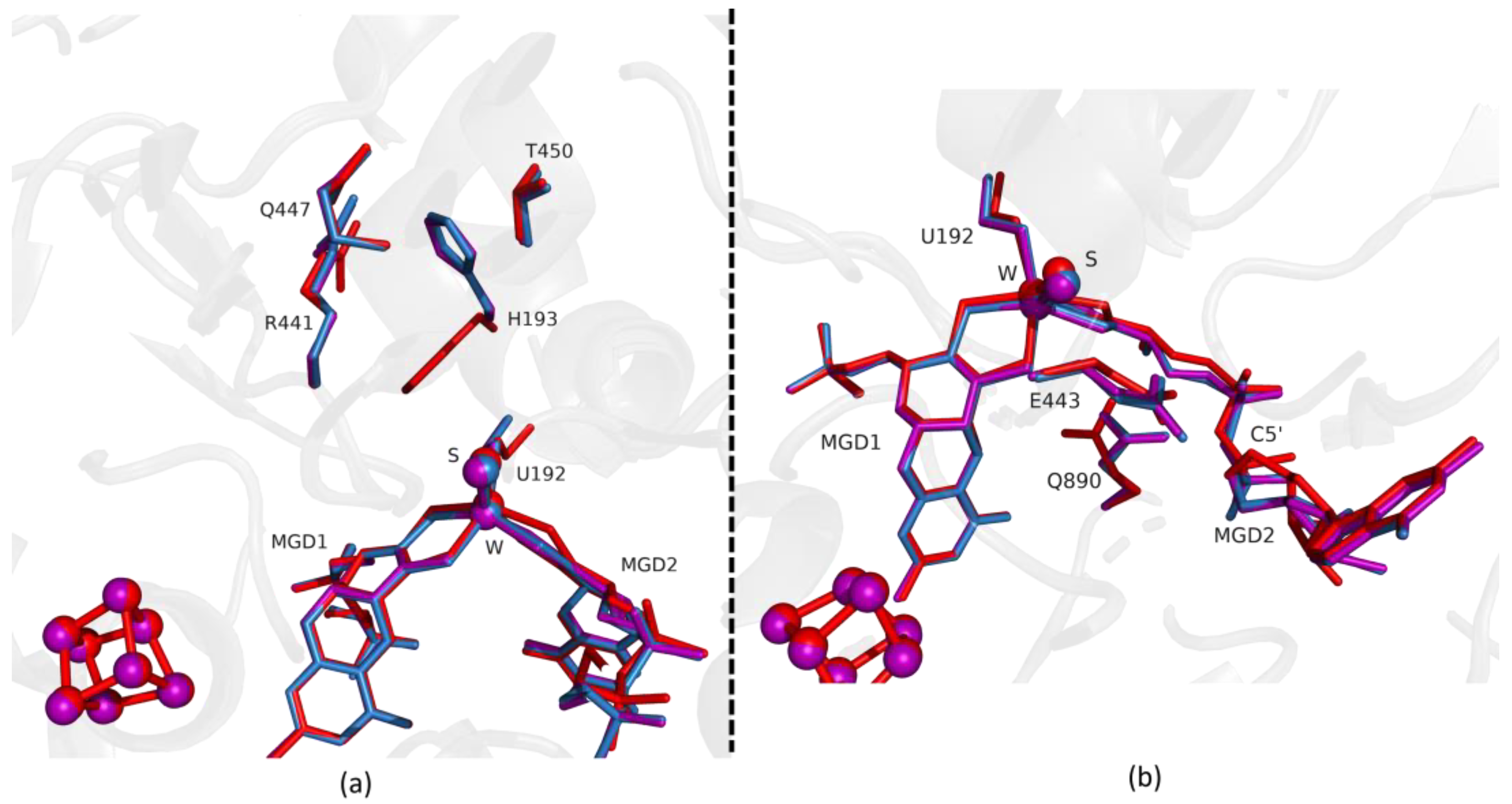
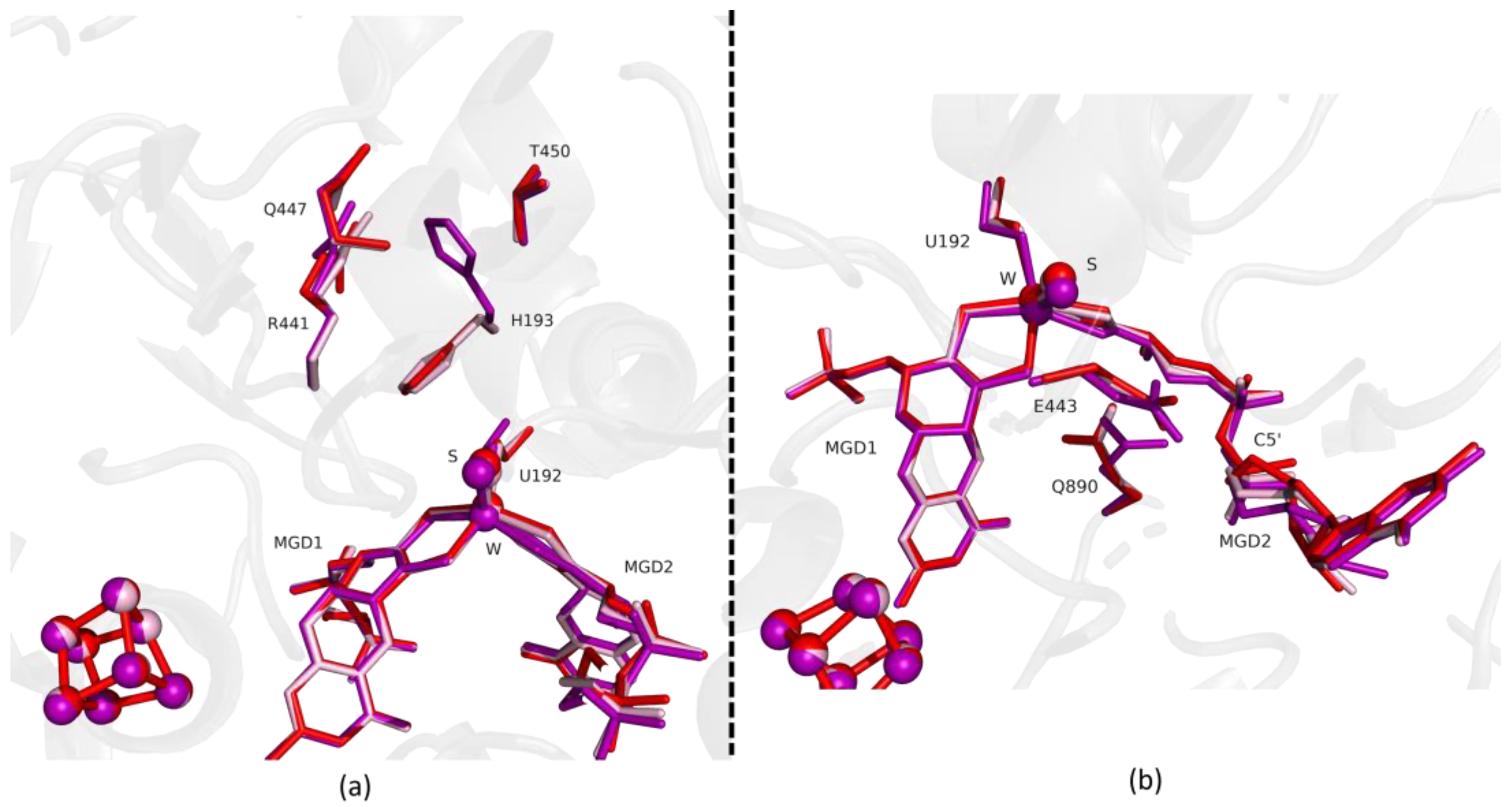
| Condition | Pre-Activation | Turnover (s−1) | Relative Activity (%) |
|---|---|---|---|
| Standard | Yes | 911 ± 113 | 100 |
| Crystallization buffer | No | 7 ± 1 | 0.8 |
Disclaimer/Publisher’s Note: The statements, opinions and data contained in all publications are solely those of the individual author(s) and contributor(s) and not of MDPI and/or the editor(s). MDPI and/or the editor(s) disclaim responsibility for any injury to people or property resulting from any ideas, methods, instructions or products referred to in the content. |
© 2022 by the authors. Licensee MDPI, Basel, Switzerland. This article is an open access article distributed under the terms and conditions of the Creative Commons Attribution (CC BY) license (https://creativecommons.org/licenses/by/4.0/).
Share and Cite
Vilela-Alves, G.; Manuel, R.R.; Oliveira, A.R.; Pereira, I.C.; Romão, M.J.; Mota, C. Tracking W-Formate Dehydrogenase Structural Changes During Catalysis and Enzyme Reoxidation. Int. J. Mol. Sci. 2023, 24, 476. https://doi.org/10.3390/ijms24010476
Vilela-Alves G, Manuel RR, Oliveira AR, Pereira IC, Romão MJ, Mota C. Tracking W-Formate Dehydrogenase Structural Changes During Catalysis and Enzyme Reoxidation. International Journal of Molecular Sciences. 2023; 24(1):476. https://doi.org/10.3390/ijms24010476
Chicago/Turabian StyleVilela-Alves, Guilherme, Rita Rebelo Manuel, Ana Rita Oliveira, Inês Cardoso Pereira, Maria João Romão, and Cristiano Mota. 2023. "Tracking W-Formate Dehydrogenase Structural Changes During Catalysis and Enzyme Reoxidation" International Journal of Molecular Sciences 24, no. 1: 476. https://doi.org/10.3390/ijms24010476
APA StyleVilela-Alves, G., Manuel, R. R., Oliveira, A. R., Pereira, I. C., Romão, M. J., & Mota, C. (2023). Tracking W-Formate Dehydrogenase Structural Changes During Catalysis and Enzyme Reoxidation. International Journal of Molecular Sciences, 24(1), 476. https://doi.org/10.3390/ijms24010476






